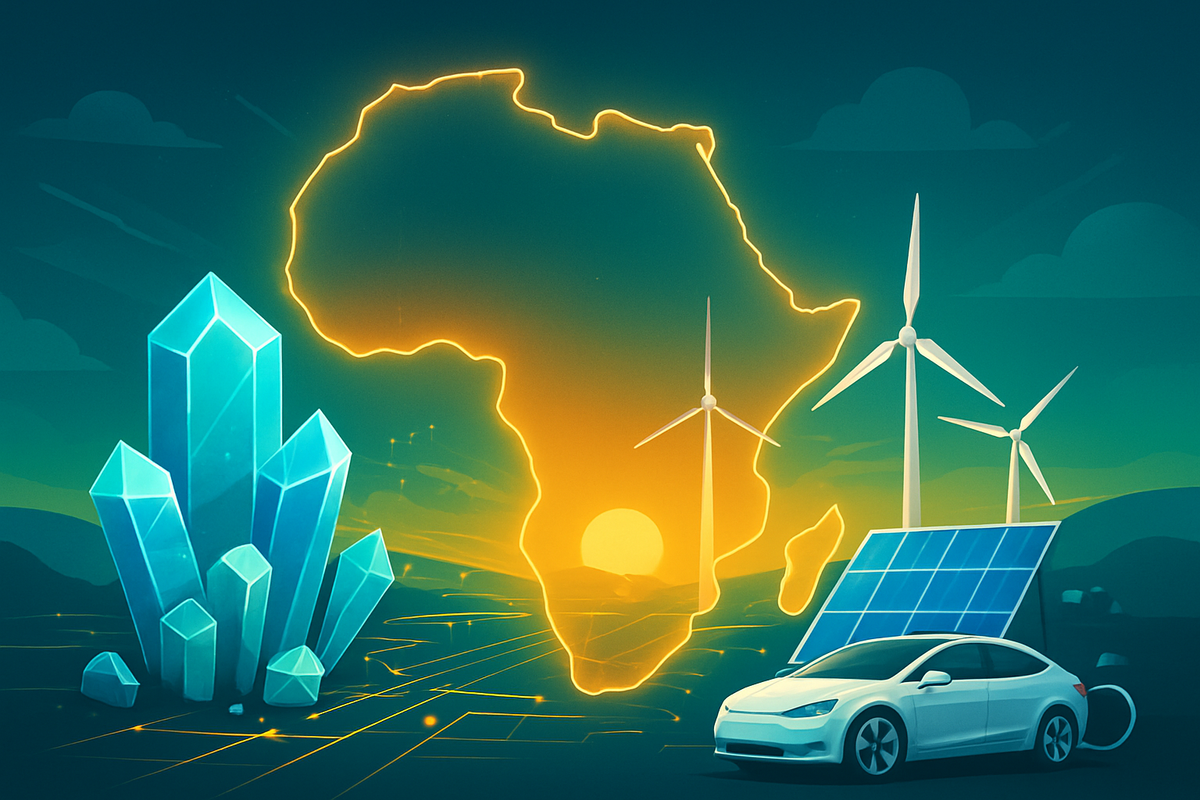
Africa stands at a pivotal juncture, possessing a staggering 30% of the world's critical mineral reserves—resources indispensable for the global energy transition. This vast wealth, ranging from cobalt and lithium to graphite and platinum group metals, presents an unprecedented opportunity for the continent to catalyze transformative economic growth and redefine its role on the global stage. As the world races towards decarbonization, the demand for these "green gold" minerals is set to surge, positioning Africa as an indispensable supplier for electric vehicles, renewable energy technologies, and advanced digital infrastructure. The immediate implications are profound, hinting at a potential paradigm shift from a resource-exporting economy to a value-adding industrial powerhouse, while simultaneously navigating complex geopolitical dynamics and socio-economic challenges.
The continent's immense mineral endowment offers a powerful lever for industrialization, job creation, and sustainable development. However, realizing this potential requires overcoming significant hurdles, including infrastructure deficits, governance issues, and the imperative to foster local beneficiation rather than merely exporting raw materials. The global scramble for these strategic resources has already ignited a new wave of international interest and competition, compelling African nations to strategically leverage their bargaining power to ensure equitable partnerships and avoid the pitfalls of past resource exploitation. The next decade will be crucial in determining whether Africa can truly harness its mineral wealth to build resilient economies and secure a prosperous future in a decarbonized world.
The Crucible of Transition: Africa's Role in the Global Mineral Supply Chain
Africa's emergence as a central figure in the global energy transition narrative is not merely aspirational; it is a geological reality backed by substantial reserves of critical minerals. The Democratic Republic of Congo (DRC) (NYSE: GLNCY), for instance, dominates the global cobalt supply, accounting for over 70% of mining and nearly half of proven reserves, making it an undeniable linchpin for lithium-ion battery production. Similarly, South Africa (JSE: BHP) (NYSE: BHP) holds a staggering 90% of the world's platinum group metal (PGM) reserves, vital for green hydrogen technologies, while countries like Madagascar, Mozambique, Namibia, and Tanzania are poised to become major players in graphite. Zimbabwe (ZSE: ZSE) and Mali (BAMAKO: MALI) are rapidly developing their lithium sectors, with Zimbabwe already ranking among the top five globally in lithium reserves, attracting significant investment for local processing facilities.
The timeline of events leading to this moment reflects a growing global awareness of mineral scarcity and supply chain vulnerabilities. Over the past five years, there has been a noticeable acceleration in bilateral agreements between African nations and major global economies, underscoring the intensifying competition for these resources. Key players and stakeholders include not only African governments and state-owned mining entities but also multinational corporations from China, the United States, and Europe, all vying for secure access. China, in particular, has established a strong foothold, often providing infrastructure development in exchange for mineral concessions. Initial market reactions have seen a surge in exploration activities across the continent, with junior mining companies and established giants alike expanding their African portfolios. Furthermore, African Union initiatives, such as the 2024 launch of the Green Minerals Strategy, signal a concerted effort by the continent to assert greater control and value addition over its resources, moving beyond the historical model of raw material export.
This strategic pivot is crucial given the projected demand surge. The International Energy Agency (IEA) forecasts a fivefold increase in lithium demand by 2040, a doubling for graphite and nickel, and a 50-60% rise for cobalt and rare earth elements. Such projections underscore the immense economic leverage Africa now possesses. However, the continent faces the dual challenge of capitalizing on this demand while simultaneously mitigating the risks of a "resource curse"—where vast mineral wealth fails to translate into broad-based economic development. The emphasis is increasingly shifting towards "beneficiation," the local processing and refining of minerals, to capture more value within Africa and foster genuine industrialization rather than just resource extraction.
Corporate Fortunes in the Green Rush: Winners and Losers
The accelerating global demand for critical minerals from Africa is set to significantly reshape corporate fortunes across various sectors. Mining giants with existing African footprints or aggressive expansion strategies are poised to be major winners. Companies like Glencore (LSE: GLEN), with its substantial operations in the DRC for cobalt and copper, and Anglo American (LSE: AAL) (JSE: AGL), a key player in South African PGMs, stand to benefit from increased demand and potentially higher commodity prices. Similarly, companies investing in lithium projects, such as Bikita Minerals (Private) in Zimbabwe, a subsidiary of Sinomine Resource Group (SHE: 002738), are already seeing significant capital inflows and development. These firms are likely to experience revenue growth, enhanced market capitalization, and strategic advantages in securing future supply.
Conversely, companies heavily reliant on traditional, carbon-intensive energy sources or those with less diversified supply chains may face increasing pressure. Manufacturers of electric vehicles (EVs) and renewable energy components, such as Tesla (NASDAQ: TSLA), BYD (HKG: 1211), and Siemens Gamesa Renewable Energy (BME: SGRE), are direct beneficiaries of a stable and ethical supply of African minerals. However, they also face the challenge of ensuring responsible sourcing and avoiding association with unsustainable or exploitative practices, which could impact their brand reputation and market access. Companies that fail to adapt to the evolving supply chain dynamics, particularly those unable to secure long-term, verifiable supplies of critical minerals, risk operational disruptions and competitive disadvantages.
The push for local beneficiation by African governments also presents both opportunities and risks. Mining companies willing to invest in in-country processing, refining, and even manufacturing facilities will likely gain favor, potentially securing more favorable licensing agreements and social licenses to operate. This could lead to significant capital expenditure for these firms but also open new avenues for profit from value-added products. Those unwilling or unable to make such investments might find themselves sidelined or facing increased export taxes on raw materials, impacting their profitability. Furthermore, the development of intra-African trade and regional value chains, spurred by initiatives like the African Continental Free Trade Area (AfCFTA), could empower emerging African industrial players and create new competitive landscapes for established global firms.
Beyond the Mineshaft: Wider Significance and Geopolitical Chessboard
Africa's critical mineral wealth is not merely an economic opportunity; it is a geopolitical fulcrum, fitting squarely into broader industry trends of decarbonization, supply chain diversification, and resource nationalism. The global energy transition necessitates a monumental shift from fossil fuels to renewables, and this transition is inherently mineral-intensive. The continent’s vast reserves offer a crucial solution to the anticipated supply crunch, making Africa an indispensable partner in achieving global climate goals. This strategic importance has amplified Africa's voice in international forums, allowing it to demand fairer terms of engagement and greater investment in local economies.
The ripple effects of this mineral boom extend far beyond the mining sector. Competitors in the global North, particularly those with less diverse domestic mineral reserves, are compelled to engage more actively with African nations, often through bilateral agreements that include technology transfer and infrastructure development. This competition creates leverage for African countries, potentially leading to more favorable investment terms and a stronger push for local value addition. Partners, especially in the renewable energy and EV manufacturing sectors, are increasingly scrutinizing supply chain ethics, pushing for more transparent and sustainable sourcing practices. This pressure could lead to improved environmental and social governance standards within African mining operations.
Regulatory and policy implications are profound. African governments are increasingly enacting legislation aimed at promoting local content, beneficiation, and environmental protection. The African Mining Vision (AMV), though established in 2009, is gaining renewed relevance as a guiding framework for sustainable mineral development. Internationally, bodies like the European Union (EU) and the United States are developing critical minerals strategies that often involve partnerships with African nations to secure supplies, sometimes offering alternatives to the dominant Chinese influence. Historically, Africa's mineral wealth has often been a source of conflict and exploitation. However, the current context, with its urgent global demand and increased African agency, presents an opportunity to break from these precedents, provided robust governance and equitable partnerships are prioritized. The continent's ability to avoid the "resource curse" and instead transform its mineral wealth into broad-based prosperity will be a defining narrative of this century.
The Road Ahead: Navigating Opportunities and Challenges
The path forward for Africa's critical mineral sector is fraught with both immense opportunities and significant challenges, demanding strategic pivots and adaptive policies. In the short term, we can expect a continued surge in foreign direct investment into exploration and mining projects across the continent. African governments will likely intensify their efforts to attract investment in local processing and refining facilities, possibly through tax incentives, special economic zones, and partnerships with technology providers. The emphasis will be on moving up the value chain, from raw ore extraction to producing battery-grade materials or even precursor components for EV batteries. This requires substantial infrastructure development—power, roads, and ports—which will be a key focus for both national budgets and international development aid.
Long-term possibilities include the emergence of fully integrated African value chains, where minerals are extracted, processed, and ultimately used in the manufacturing of finished products like electric vehicles or renewable energy components within the continent. This ambitious vision would necessitate significant human capital development, technological transfer, and robust regional integration, potentially facilitated by the African Continental Free Trade Area (AfCFTA). Market opportunities will emerge for African entrepreneurs and businesses in logistics, engineering, and manufacturing, creating a more diversified and resilient economic base. However, challenges such as volatile commodity prices, geopolitical instability in certain regions, and the imperative to ensure environmental sustainability and social equity will remain paramount.
Potential scenarios range from a highly successful "African green industrialization" where the continent becomes a major player in the global clean energy economy, to a less favorable outcome where external powers continue to dominate the value chain, leaving Africa primarily as a raw material supplier. To achieve the former, strategic adaptations will include strengthening governance and regulatory frameworks to combat corruption, investing heavily in education and skills training, and fostering regional collaboration to build economies of scale. What emerges next will largely depend on the collective will of African nations to implement coherent, long-term strategies and their ability to negotiate equitable partnerships that prioritize local development over short-term gains.
A New Dawn for Africa's Mineral Economy: A Concluding Assessment
Africa's vast critical mineral reserves represent a transformative opportunity, positioning the continent as an indispensable player in the global energy transition. The key takeaway is that Africa is no longer merely a source of raw materials but has the potential to become a central hub for green industrialization, leveraging its mineral wealth to drive profound economic growth and diversification. This shift, however, is contingent on the continent's ability to overcome significant challenges, particularly in enhancing local value addition through beneficiation, addressing infrastructure deficits, and strengthening governance frameworks to ensure equitable and sustainable development.
Moving forward, the market will be characterized by intense competition for mineral access, prompting both African nations and international partners to seek more strategic and mutually beneficial engagements. Investors should closely watch for policy developments within African countries aimed at promoting local content and processing, as these will significantly influence operational strategies and profitability for mining companies. Furthermore, the success of regional integration initiatives like the AfCFTA in fostering intra-African mineral value chains will be a critical indicator of the continent's long-term economic trajectory.
The lasting impact of this era could be a redefinition of Africa's global economic standing, moving from a periphery player to a central pillar of the future green economy. However, the risk of repeating historical patterns of exploitation remains real, underscoring the urgency for robust, transparent, and inclusive strategies. What investors should watch for in the coming months are concrete steps towards infrastructure development, the establishment of clear and stable regulatory environments, and the formation of genuine partnerships that prioritize sustainable development and shared prosperity across the African continent. The "green gold" era is here, and Africa's strategic response will shape its destiny for generations to come.
This content is intended for informational purposes only and is not financial advice






